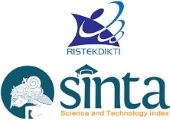Analisis Tingkat Kepuasan Pengunjung Daya Tarik Wisata Kebun Raya Balikpapan
Abstract
Dalam penelitian ini penulis menganalisis tingkat kepuasan pengunjung Daya Tarik Wisata Kebun Raya Balikpapan, penelitian ini bertujuan untuk mengetahui tingkat kepuasan pengunjung berdasarkan faktor-faktor yang mempengaruhinya serta menentukan faktor yang paling dominan yang mempengaruhi tingkat kepuasan pengunjung wisata. Tingkat kepuasan pengunjung dibatasi pada 6 faktor yang berpengaruh yaitu pemandangan, aksesbilitas/kemudahan , keamanan atau kenyamanan, kondisi dan ketersediaan fasilitas, kondisi jalan, serta pelayanan informasi yang terdapat pada Obyek Wisata Kebun Raya Balikpapan. Metode yang digunakan yaitu metode penelitian deskriptif kuantitatif berdasarkan data yang didapatkan melalui kuisioner. Teknik analisis data yang digunakan yaitu analisis kuantitatif mean aritmatik untuk mengetahui tingkat kepuasan pengunjung objek wisata kebun raya Balikpapan. Hasil dari penelitian ini menunjukkan bahwa terdapat enam faktor yang mempengaruhi tingkat kepuasan pengunjung Daya Tarik Wisata Kebun Raya Balikpapan. Tingkat kepuasan pengunjung berada pada nilai 3,89 yang berada pada kriteria 3,40 - 4,19 yang masuk dalam kategori puas. faktor keindahan pemandangan yang memberikan sumbangan tingkat kepuasan yang tertinggi dengan nilai 4,08 kemudian faktor Kondisi jalan dan Akses atau kemudahan, dengan nilai 3,99 sedangkan faktor yang memberi tingkat sumbangan terhadap kepuasan terendah adalah faktor Kondisi Keamanan atau kenyamanan obyek wisata dengan nilai 3,73
ANALYSIS OF SATISFACTION VISITORS OF BALIKPAPAN BOTANICAL GARDENS TOURIST ATTRACTION
ABSTRACT
In this study, the authors aims to analyze the level of visitor satisfaction at the Balikpapan Botanical Gardens Tourism Object. This study aims to determine the level of visitor satisfaction based on the factors that influence it and determine the most dominant factor affecting the level of visitor satisfaction. The level of visitor satisfaction is limited to 6 influencing factors, the view, accessibility / convenience, security or comfort, condition and availability of facilities, road conditions, and information services contained in the Balikpapan Botanical Garden Tourism Object. The method used is descriptive quantitative research method based on data obtained through questionnaires. The data analysis technique used is the arithmetic mean quantitative analysis to determine the level of visitor satisfaction at Balikpapan Botanical Gardens. The results of this study indicate that there are six factors that influence the level of satisfaction of visitors to the Balikpapan Botanical Gardens Tourism Object. The visitor satisfaction level is at a value of 3.89 which is in the criteria of 3.40 - 4.19 which is included in the satisfied category. the factor of the beauty of the scenery that contributed to the highest level of satisfaction with a value of 4.08 then the factor of road conditions and access or convenience, with a value of 3.99 while the factor that contributed to the lowest level of satisfaction was the factor of security conditions or the comfort of a tourist attraction with a value of 3, 73.
Keywords: Arithmetic mean, Botanical garden, Satisfaction level
Keywords
Full Text:
PDFReferences
Adnyani, N. D., dan Sukerti, N. W. (2015), “Strategi Pengembangan Agrowisata Salak Di Desa Sebetan Kabupaten Karangasem”, Jurnal Pendidikan dan Kesejahteraan Keluarga, Vol 4, hal. 244-252.
Alegre, J., & Garau, J. (2010). Tourist satisfaction and dissatisfaction. Annals of tourism research, 37(1), 52-73.
Arikunto, Suharsimi (2002). Prosedur Penelitian Suatu Pendekatan Praktek.Jakarta:Rineka Cipta
Baharuddin, A., Kasmita, M., dan Salam, R. (2016). Analisis Kepuasan Wisatawan Terhadap Daya Tarik Wisata Malioboro Kota Yogyakarta. Ad’ministrare, 3(2), 107-112.
Bitner, M. J., & Hubbert, A. R. (1994). Encounter satisfaction versus overall satisfaction versus quality. Service quality: New directions in theory and practice, 34(2), 72-94.
Bowen, D., & Clarke, J. (2002). Reflections on tourist satisfaction research: Past, present and future. Journal of Vacation Marketing, 8(4), 297-308.
Framke, W. (2002). The Destination as a Concept: A Discussion of the Business-related Perspective versus the Socio-cultural Approach in Tourism Theory. Scandinavian Journal of Hospi-tality and Tourism, 2 (2): 92-108.
Friscarnela, R. B. (2018). Identifikasi Fungsi Kebun Raya Bogor Sebagai Ruang Terbuka Hijau (Rth) Publik. Jurnal Online Mahasiswa (Jom) Bidang Perencanaan Wilayah & Kota, 1(1).
Ghozhali, Imam, (2011), Aplikasi analisis multivariate dengan program IBM SPSS 20,00.Universitas Diponegoro,, Yogyakarta.
Leiper, N. (1979). The framework of tourism. Annals of Tourism Research, 6(4), 390–407.
Lew, A. A. (1987). A Framework of Tourist Attraction Research. Annals of Tourism Research, 14 (4): 553-75.
Liu, C. H., & Yen, L. C. (2010). The effects of service quality, tourism impact, and tourist satisfaction on tourist choice of leisure farming types. African Journal of Business Management, 4(8), 1529-1545.
Luthfi, R. R., & Suman, A. (2012). Peran Pariwisata Terhadap Kesejahteraan Masyarakat di Sektor Lapangan Pekerjaan Dan
Perekonomian Tahun 2009–2013 (Studi Kasus: Kota Batu). Jurnal Ilmiah Mahasiswa FEB, 1(2).
Margaret, A. (2011). Profil Wisatawan Museum Radya Pustaka Surakarta, Universitas Sebelas Maret, Surakarta.
Melinda, M. (2019). Permasalahan Pengembangan Potensi Pariwisata.
Morgan, M., Lugosi, P., & Ritchie, J. B. (Eds.). (2010). The tourism and leisure experience: Consumer and managerial perspectives (Vol. 44). Channel View Publications.
Pendit S, Nyoman, (2003), Ilmu Pariwisata, PT Pradnya Paramita, Jakarta.
Pizam, A., & Milman, A. (1993). Predicting satisfaction among first time visitors to a destination by using the expectancy disconfirmation theory. International Journal of Hospitality Management, 12(2), 197-209.
Sarchers, M. M. V. (2004). Kepuasan konsumen terhadap atribut-atribut tempat kebugaran Olympia di kota Surakarta.
Sriyono, A. (2020). Kiprah Kebun Raya Banua Dalam Menjalankan Lima Fungsi. Warta Kebun Raya, 18(1), 34-48.
Sugiyono. (2017). Metode Penelitian Kuantitatif, Kualitatif, dan R&D. Bandung : Alfabeta, CV.
Tondobala, L. (2012). Kelayakan Pusat Kota Manado Sebagai Destinasi Pariwisata. Media Matrasain, 9(3), 82-103.
Wijono, D. (2014). Tingkat Kepuasan Pengunjung Obyek Wisata Pantai Kuwaru Sanden Bantul Yogyakarta. Jurnal Maksipreneur: Manajemen, Koperasi, dan Entrepreneurship, 4(1), 22-35.
Yu, X., KIm, N., Chen, C. C., & Schwartz, Z. (2012). Are you a tourist? Tourism definition from the tourist perspective. Tourism Analysis, 17(4), 445-457.
DOI: https://doi.org/10.17509/jithor.v4i1.28205
Refbacks
- There are currently no refbacks.

This work is licensed under a Creative Commons Attribution-ShareAlike 4.0 International License.
eISSN : 2654-4687
pISSN : 2654-3893
This work is licensed under Creative Commons Attribution-ShareAlike 4.0 International License














